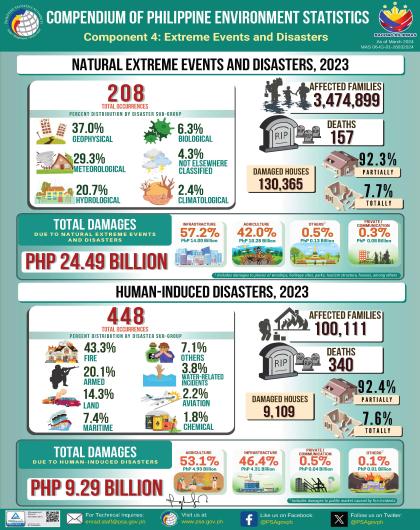Water Accounts of the Philippines
The country’s water use efficiency (WUE), or the value added per volume of water used, increased from PhP 192.25 per cubic meter of water used in 2020 to PhP 200.06 per cubic meter in 2021. The services sector consistently had the largest WUE, followed by the industry and agriculture sectors from 2010 to 2021. It is notable that for the same period, the services sector contributed more than 63.5 percent to the total gross value added but only shared 10.3 percent to the water used. On the other hand, the sectors of industry and agriculture correspondingly contributed 30.6 percent and 5.9 percent to the total gross value added while sharing 13.4 percent and 76.2 percent to the total water used, respectively. (Figure 1 and Table 3)
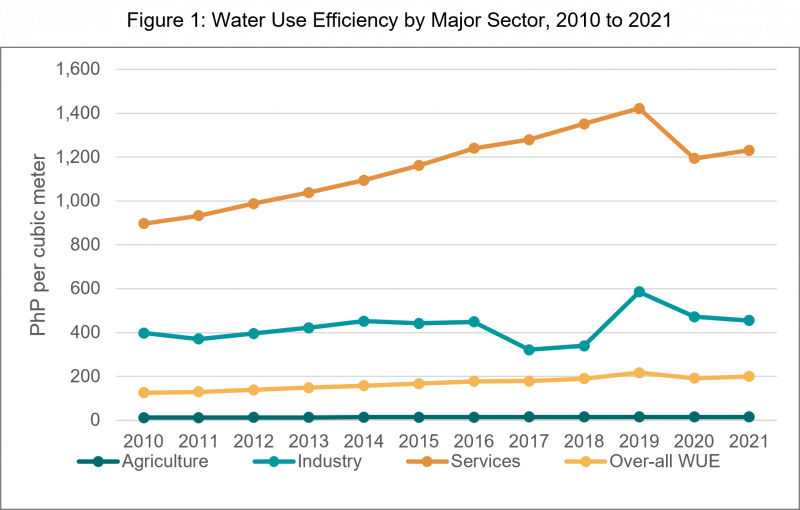
The level of water stress or freshwater withdrawal as a proportion of available freshwater resources, slightly increased from 26.7 percent in 2020 to 27.2 percent in 2021. The highest level from 2010 to 2021 was observed in 2018 at 28.2 percent. The annual level of water stress consistently fell within the low-level classification range of 25.0 to 50.0 percent. (Figure 2 and Table 4)
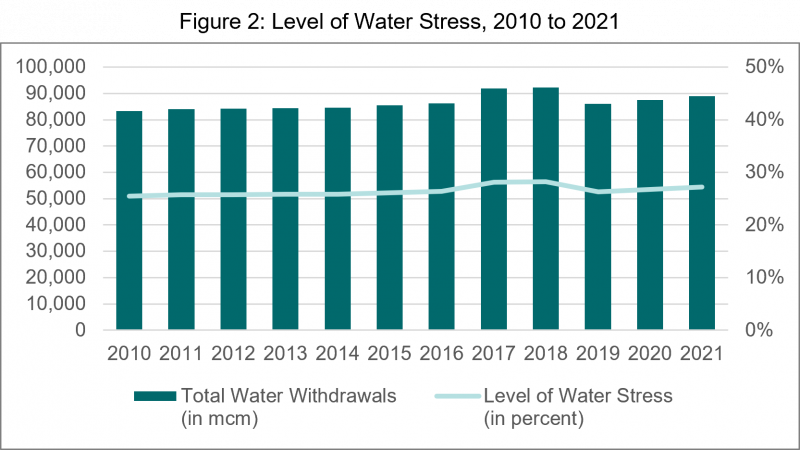
It should be noted that freshwater withdrawals for both indicators exclude hydropower generation due to its non-consumptive use. That is, water remains in or is immediately returned to the location from where it was extracted. Also, Water Supply and Waste Management is included in the services sector, in alignment with the global methodology for Sustainable Development Goal (SDG) 6.4.1: Change in Water Use Efficiency. In addition, parameters on the available water resources of the Philippines, particularly the total renewable freshwater resources and environmental flow requirements, were adopted from the AQUASTAT database of the Food and Agriculture Organization of the United Nations, the international custodian agency for SDG Target 6.4: Increase Water-Use Efficiency and Ensure Freshwater Supplies.
The total water abstraction, or the amount of water that is removed from its source, either permanently or temporarily increased by 1.3 percent, from 218.6 billion cubic meters (bcm) in 2020 to 221.3 bcm in 2021. From 2010 to 2021, on the average, 98.0 percent of the total abstraction was from lakes, artificial reservoirs, rivers and streams and the remaining 2.0 percent was from groundwater reservoirs. On the average, 98.7 percent of the abstracted water was for own use, while the remaining 1.3 percent was intended for distribution to other economic units. (Figure 3, and Tables 1.1 to 1.12)
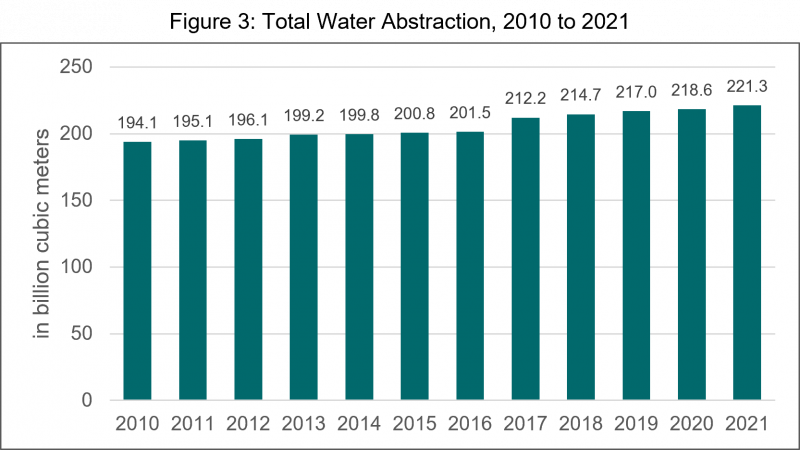
Water abstracted for own use also increased from 215.2 bcm in 2020 to 217.8 bcm in 2021. From 2010 to 2021, the largest amount of self-abstracted water is for the power sector (58.7%). This was followed by agriculture (33.5%); mining and quarrying, manufacturing, and construction (5.3%); and services sector and households (2.6%). (Figure 4, and Tables 1.1 to 1.12)
Similarly, the amount of distributed water also increased from 2.49 bcm in 2020 to 2.52 bcm in 2021. From 2010 to 2021, households had the largest share in the distributed water (37.3%). This was followed by the services sector (34.0%); and mining and quarrying, manufacturing, and construction sectors (22.3%). The smallest amount of distributed water was used by the sectors of agriculture and power. Generally, the services sector and households are connected to municipal water systems that facilitate water collection, treatment, and distribution. (Figure 5, and Tables 1.1 to 1.12)
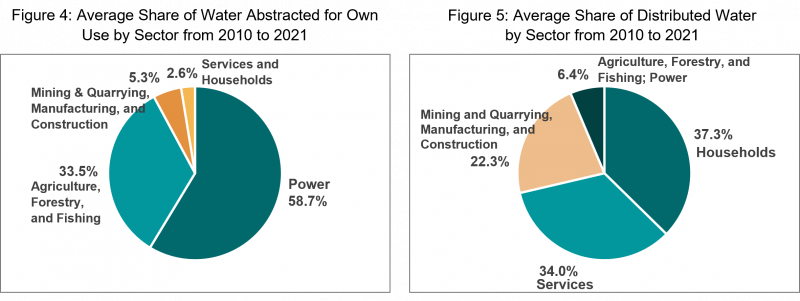
During the 12-year period, households consistently had the largest share to total expenses on water. In 2021, households’ expenses on water amounted to Php 56.23 billion. This was followed by mining and quarrying, manufacturing, and construction sectors; and services sector, amounting to Php 44.72 billion and Php 35.92 billion, respectively. (Figure 6, and Tables 2.1 to 2.12)
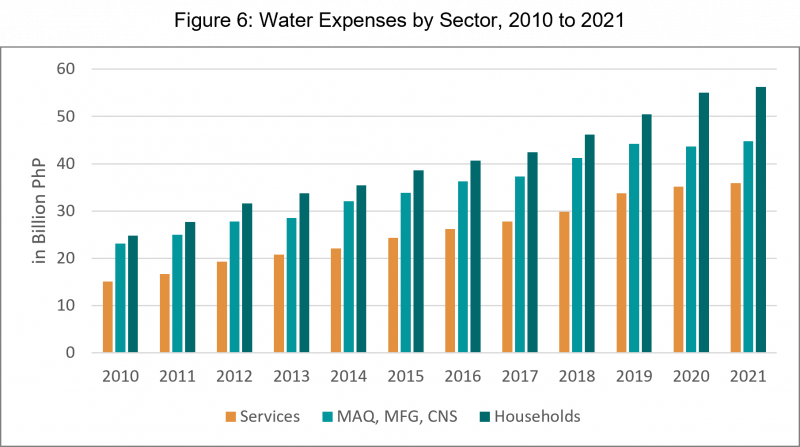
The supply and use of water resources follow the System of Environmental-Economic Accounting (SEEA) 2012 Central Framework which was adopted as an international statistical standard and is aligned with the System of National Accounts. The water accounts provide information on the rate of extraction and the use of water by different economic units.
DIVINA GRACIA L. DEL PRADO, Ph.D.
(Assistant National Statistician)
Officer-in-Charge, Deputy National Statistician
Sectoral Statistics Office






